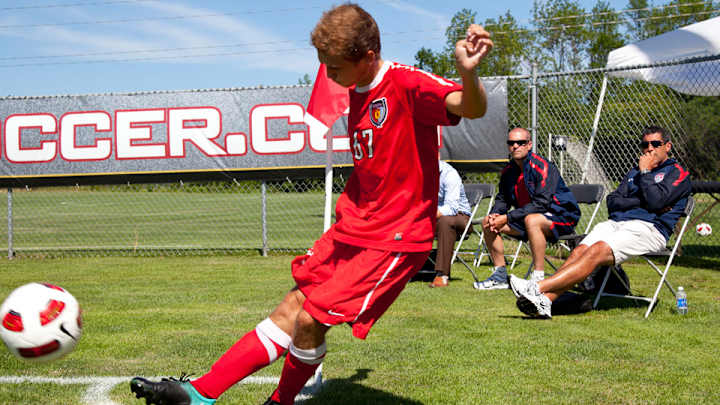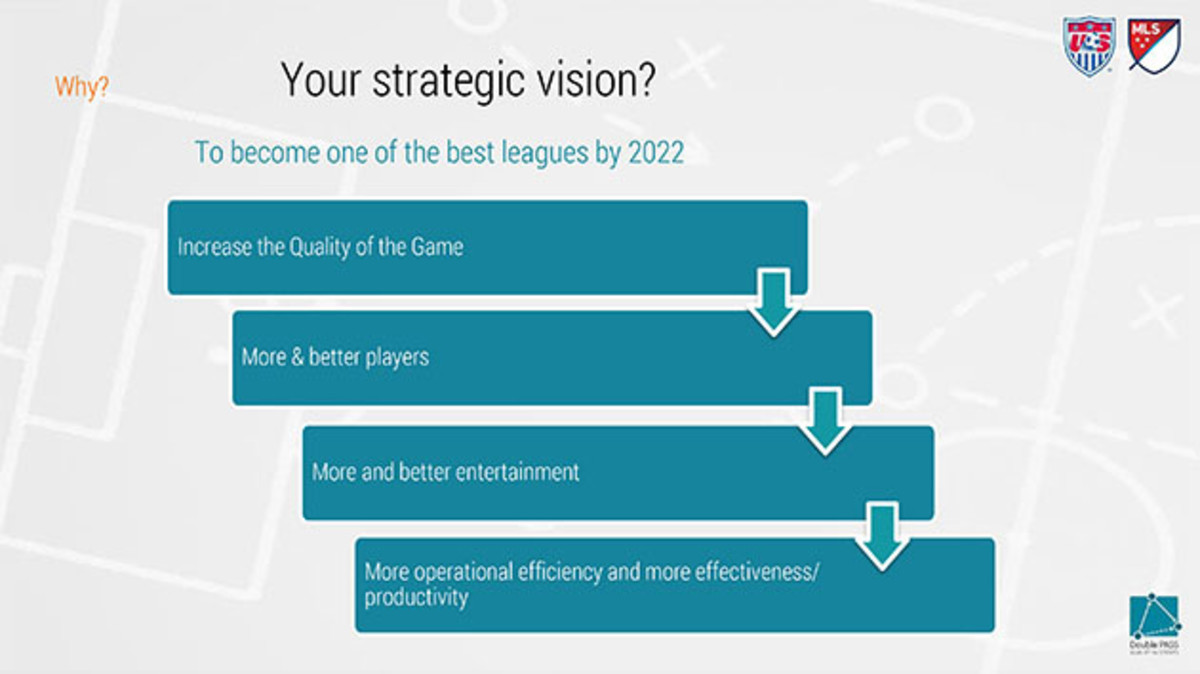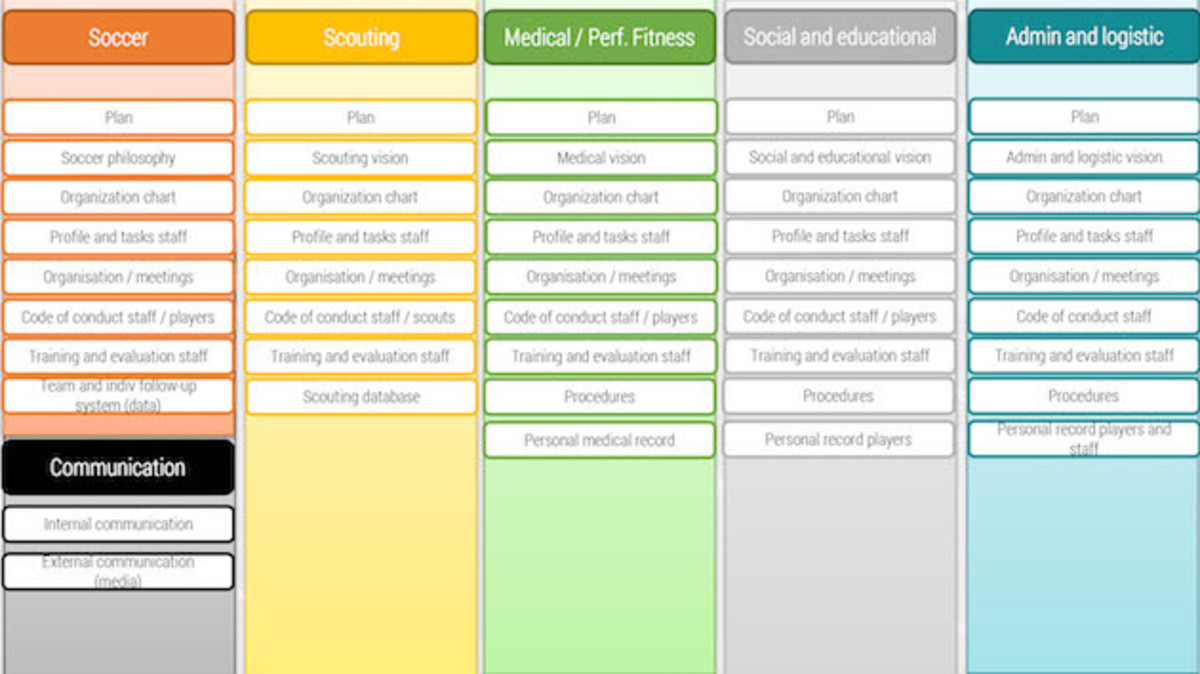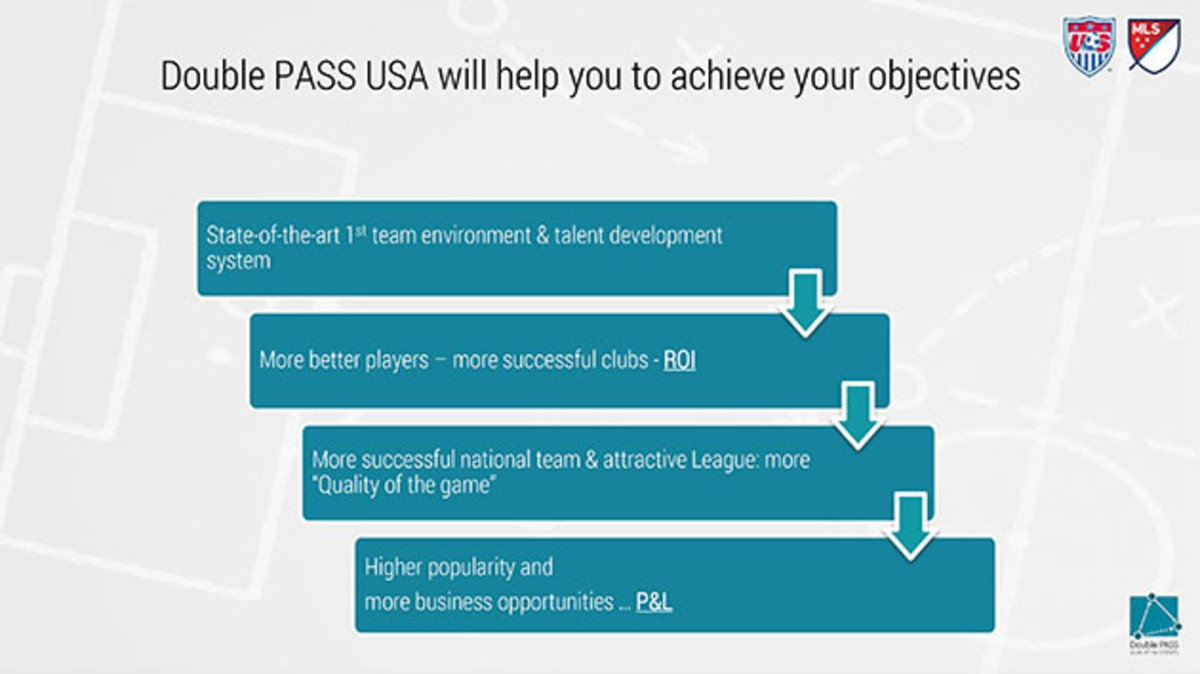Double PASS and its plan to change U.S. Soccer

As 2016 shapes up to be a pivotal year in player and coaching development in the United States, Planet Fútbol dives into just what American clubs and the federation are doing in their quest to evolve as a soccer nation. This is the first of a three-part series on the subject.
The company that helped turn Germany into a world champion and Belgium into the current top-ranked team in the world is now working with the United States. Double PASS, an offshoot of the University of Brussels Department of Sport Management, is a group of the most detailed football auditors on the planet. By mid-2017, every Major League Soccer franchise and each member of the U.S. Soccer Development Academy will go through its process, which started in August 2015.
So far, Double PASS has visited the New York Red Bulls, Philadelphia Union, FC Dallas, LA Galaxy, Seattle Sounders, Vancouver Whitecaps, New England Revolution, Columbus Crew, Portland Timbers, Sporting Kansas City, D.C. United and Chicago Fire in MLS, as well as Colorado Rush, Players Development Academy (New Jersey), St. Louis Scott Gallagher, Dallas Texans SC, Capital Area (North Carolina) Railhawks, De Anza (California) Force, Real So Cal and Kendall SC (Florida) among non-MLS academies. The assessments continue this spring.
Late Altidore goal rescues wasteful U.S. in friendly win over Canada
Club visits are the last step of the process, which will have taken about two years by the time the cycle is complete. First, clubs uploaded a vast number of documents that cover every aspect of their operations to Double PASS’s servers for review. Next, one of three Double PASS teams of three assessors interviewed multiple staff members. Observation of multiple training sessions and games, both live and on video, followed to create a complete picture that allows for an accurate assessment.
The general response from clubs has been positive, U.S. Soccer director of sport development and project lead Ryan Mooney said.
“It’s about wanting to know what they need to do to get better. I think that the overwhelming majority of our clubs and their leaders are not adverse to constructive criticism,” Mooney told SI.com in January. “They understand the reality of where they are at and where we are at this moment in time, and that if there are things that need to be improved upon, they want to be part of making those improvements.”

Before setting foot on a training ground, though, Double PASS had to know exactly what it needed to assess. Its general model is based on eight areas of evaluation: strategic and financial planning; organizational structure and decision-making; talent identification and development; support staff, including medical, social and educational; technical staff; internal and external communication; facilities; and productivity, or effectiveness of the club.
“The first thing we do … is always what we call customization,” said Hugo Schoukens, CEO of Double PASS. “What we first do is discuss these [eight categories] with experts from the country in which we are going to do these audits.”
The names behind the partnership
Within its eight critical areas, Double PASS has identified between 700 and 800 specific standards of measurement. To ensure proper focus on the right aspects for the U.S. market, the company assembled a task force of 15 experts from U.S. Soccer and MLS to synthesize the assessment tool in a manageable way.
Mooney, Development Academy director Jared Micklos, director of coaching development Dave Chesler, director of scouting Tony Lepore and technical adviser Dave van den Bergh represented the federation on the task force. Executive vice president Todd Durbin and vice president of competition Jeff Agoos represented MLS. Directors Luchi González (Dallas), Pete Vagenas (LA) and Craig Dalrymple (Vancouver) represented the MLS academies, while Kansas City head coach Peter Vermes represented the first teams. Chicago Sockers FC president and technical director David Richardson represented the non-MLS academies, while Schoukens, Jo van Hoecke, Frank Rits and Henk Mariman represented Double PASS and U.S. Soccer youth technical director Tab Ramos represented the federation to round out the task force.
Improved approach makes Lee Nguyen a U.S. January Camp winner
“It was important for us to recognize that we’re not Holland, we’re not Belgium, we’re not Germany, we’re not England. We’re unique,” Mooney said. “Whether it’s our soccer landscape culture, whether it’s our size, whether it’s just our own culture as a nation, there are lots of different factors that we need to account for [in] how it is we would evaluate our environment.”
At the same time, those involved wanted to ensure they kept the essence of Double PASS intact.
“At the core of this project,” Mooney said, “there’s also an interest in having a better understanding as to how we compare internationally.”

A wide-ranging checklist and questionnaire resulted from the customization process and was sent to each club, detailing the documents to be submitted by Aug. 15, 2015. They included broad requirements such as defining the club’s on-field philosophy and job descriptions for each member of the staff, down to details such as the club’s policy regarding confidential personnel files and describing the structure of meetings with the club’s players’ council or senior members of the first team.
“The model, the process itself, doesn’t change a lot. Of course, we are confronted with some approaches that are for us in Europe totally different,” Schoukens said. “So we adapted the system, but all the critical success factors that we have in Europe are used also in the States.”
In Germany, clubs are preparing for the fourth cycle of Double PASS assessments (the company is known as Foot PASS in Europe), the first of which began in 2005. Academies there are rated on a scale from zero to three stars. The English assessments, going on their second cycle after beginning in 2012, set clubs into Category 4 through Category 1. In Belgium, youth academies are put into leagues only with others that receive similar marks, serving as a de facto promotion-relegation system.
“We had one period where we had only two stars. There were some problems because they decided, for example, it’s a must to have a sports psychologist also in the club; we didn’t have that in 2009,” said Sebastian Dremmler, Bayern Munich Under-16 coach and head of academy match operations. “[During the assessments,] we show our life, our mentality. For example, we have clubs in Germany that have big, big history—St. Pauli, for example, [and] Hamburg. They are the fighting machines. The fans with tattoos. … Foot PASS cannot say, ‘That’s not good enough for us,’ because that’s their own style. This style is also important for German football.”
According to Double PASS documentation, the average number of homegrown players in the Bundesliga has grown by 23%, and club investments in development have increased 51% since the first assessment. The national team also went from being ranked No. 16 by FIFA in 2005 to winning the 2014 World Cup.
USA's Jerome Kiesewetter makes strong impression to start crucial year
In Belgium, Double PASS’s home country with which it has worked closely since 2003, the results have been nothing short of astounding. The nation of 11 million is the world’s top-ranked team after a quarterfinal finish at the World Cup, after failing to qualify for five successive World Cups and European Championships. RSC Anderlecht went from finding 8% of its first-team squad in its own academy in 2004 to 52% in 2014.
“This is a long-term plan,” Schoukens said. “You can imagine with the European model working already 12 or 13 years, the bar today to run an academy is very high.”
Closing the standard gap
The U.S. remains far away from the standard in Germany and Belgium, but like the creation of the Development Academy in 2007, bringing in outside help such as Double PASS marks a step on the path toward becoming a heavyweight soccer nation. The term “world-class” might seem to lose some of its meaning with U.S. Soccer’s use of it to promote the Academy, but that doesn’t mean federation officials believe they’ve developed any players that fit the moniker so far.
“We haven’t. We are closer now than we were eight years ago when the program started, but we’ve got a lot more work to go,” Mooney said. “There’s no doubt after eight years that we’ve made a lot of progress in that program. Some of it’s anecdotal, which is fine. For this, we had a real chance to have a very experienced and objective and formal process be applied to give us more information, more data points for us to continue to move the program forward and, ultimately, to help influence and support those club environments that are really involved on an everyday basis with developing players.”
Jordan Morris's future in fine shape despite passing on Werder Bremen
Contracting a Belgian company in Double PASS is one of several nods to the European football process that Americans have made in recent business decisions in the game. U.S. Soccer hired Nico Romeijn from the Netherlands as its director of coaching education in June 2015 to overhaul its licenses.
Since 2013, MLS also maintains a partnership with the French Football Federation for coaching education.
“It all starts with creating awareness, and that’s also why it’s good to compare [American soccer] with Europe … and then look how you can take things and modify it and implement it in the U.S. soccer culture,” Romeijn said. “The biggest mistake we can make is just copy things.”

In its presentation to U.S. clubs ahead of launching the assessments, Double PASS eschewed any comparisons and simply stated its goal as a series of progressive steps: create a “state-of-the-art first-team environment and talent development system,” which leads to improved players, professional clubs and national teams, a more attractive MLS and “higher popularity and more business opportunities.”
The U.S. youth national teams are also being assessed, though the U-17s with their residency program currently have the only everyday environment similar to a club team. Still, Mooney said the process remains generally the same.
“We want to hold ourselves and those environments to a higher standard,” Mooney said. “So for us, we’re very much part of this process as well, and we need to make sure that we’re improving over the next five, 10-plus years.”
Leicester City's magical run continues with 3-1 win over Manchester City
After the Double PASS assessment, each club receives a written report and presentation detailing each aspect of the study and its resulting conclusions. The written report deals largely with the documents submitted before the on-site visit, coupled with whether the observed environment accurately reflects those documents, while the presentation covers the specific training sessions and matches seen.
“For years, [club name] teams have succeeded in regional, national and international tournaments,” reads one final assessment, shared with SI.com by one official on the condition of anonymity. “To ensure continuity, it is important that all procedures and future ambitions are formalized. This process, together with a formal technical structure, a detailed curriculum, making a start of individual development of the academy players, extra staff to undouble roles, an increase of practice time, acquiring a centralized data management system will make the level of [club name] high also during [the coming] years.”
2015 Year in Review: U.S. men's, women's youth national teams
The presentation on games and training details multiple aspects of Double PASS’s defined “game canvas” that includes attacking, defensive and transition moments and the club’s effectiveness compared to academies in major European nations. It details how many sessions Double PASS observed, the average number of exercises per session, average training time and the average number of coaches involved in each.
Finally, a series of graphs close out the report, detailing the distribution of training content, number of game-realistic exercises, the type of interaction coaches have with players and other session characteristics. A few recommendations on how to improve the club’s training environment follow.
Clubs who went through the process in 2015 received their assessments and had their closing discussions with Double PASS during the MLS Combine and NSCAA Convention in January.
How is development incentivized?
One area of lingering uncertainty remains how Double PASS’s assessments will be used to incentivize development, and whether the final reports will carry with them any consequences, such as Belgium’s promotion-relegation system or Germany and England’s financial rewards that come with having higher-ranked academies.
The German federation parses out a section of its annual UEFA Champions League solidarity funding to the Bundesliga and 2. Bundesliga academies. In his recent book, Das Reboot, Raphael Honigstein reports that three-star academies receive €400,000, while those with zero stars receive €100,000. Champions League-qualified clubs receive no money beyond what UEFA pays them for their participation and results.
EPL Notes: Mourinho the loser as Man United draws Chelsea
In England, the Premier League provides funding on a sliding scale according to a club’s assessment. In the first cycle of assessments, Category 1 clubs received £750,000, but they had to match the league’s funding by earmarking the same amount for development. Clubs could choose which categorization to aim for, depending on how much they wanted to invest on their own into their academy with the knowledge that it would be doubled.
For now, U.S. Soccer hasn’t decided what its final measurement system will be, let alone whether a certain grade would carry with it any reward.
“The incentive side is also interesting to us,” Mooney said. “In fairness, at the moment, it’s probably a little premature for two reasons. One is that we don’t yet know enough—we haven’t basically evaluated enough clubs—to have an understanding of what an incentive program would really look like for our environment. It’s also the case where we have a unique environment with a combination of professional and amateur clubs, and how those clubs are funded and resourced in different ways.”
Double PASS believes the incentive system connected with its certification is a big reason for the success of the nations with which the company works in Europe. Its CEO, Schoukens, mentioned return on investment as a major driving factor for the work academies do.
“For us, it’s a little bit strange that Development Academies end their development at [age] 18. What is the next step?” Schoukens said. “The objective of setting up an academy is to bring them to your first team, in Europe; that’s the basic idea.”
In the U.S., college soccer remains a major draw for players graduating from Development Academy teams. However, if players don’t sign homegrown player contracts out of MLS academies and expenses-paid clubs aren’t compensated for moving players on, Schoukens said it’s difficult to find any return on the clubs’ investment in development.
“If you consider not the pay-to-play system—if you consider it as for-free development—well then, the return on investment should be provoked by the transition of players into the first team,” he said. “So the business model of the Development Academies today is a business model, I think, for 50% of these clubs based on the pay-to-play system; 50% are already evolving into for-free development. But then my question is, where are they going to find their return on investment? Because at 18, thank you very much, I got a good education or a good development in your club and now, what is the next step?”
U.S. prospect Christian Pulisic a fast-rising talent at Borussia Dortmund
A financial incentive, Schoukens said, could be a step in the process toward eradicating the pay-to-play system that limits participation in elite soccer only to those who can afford the costs and rewarding all academies, whether they are connected to MLS franchises or not, for developing players.
“Why should [the academies] do this [work without reward]?” he said. “There is always the intrinsic motivation, but there is also the extrinsic motivation. By the end, people can be idealists, but at a certain moment, that ends.”
Mooney said the federation hasn’t ruled out some sort of incentive system.
“I think that our first steps in that would be wanting to find ways for the incentives to be based on those areas that they need to improve,” Mooney said. “Maybe that’s the incentive that we connect with a particular star rating: to make sure that they have increased access to an opportunity, or that there’s a potential scholarship program for those coaches.”
As it stands, without a measure of reward or punishment, clubs could simply disregard Double PASS’s recommendations. Of course, U.S. Soccer constantly evaluates its academies formally anyway, admitting and dropping clubs based on the federation’s standards, so these assessments aren’t purely an exercise in accountability.
U.S. Soccer also hasn’t decided when the next round of Double PASS evaluations could be. With only around one-quarter of its Development Academies going through the process so far, Mooney said it’s far too early to tell what the future of the partnership could look like.
“While there are certainly ideas projecting forward about having assessments that are conducted on an every-two-year basis and that there becomes a formalized ranking, rating and/or incentive scale, a lot of that’s premature,” Mooney said. “As we continue through this process, the real hope is that if I think of it as a checklist—so I’ve got 10 things that I really need to improve on—it’s less realistic to think that I can solve all 10 problems between my first assessment and my second one. For us, it’s about formalizing that strategy and that plan to say, ‘Can I solve one of these things each year over the next 10 years?’”
The countries that have seen the most reward from their partnerships with Double PASS needed multiple cycles of evaluation to reach their current heights. As it stands, that means the U.S. might not be in a position to make much progress in the current World Cup cycle, but long-term adherence to the Double PASS model of meta-development would likely bring far greater results than a one-time assessment of the American environment.
“We put the bar already very high in Europe, and probably, we have set the bar at this moment not at the same level [in the U.S.],” Schoukens said. “They will still have a lot to do, but there is already a strong base. It’s now a question to optimize it.”
